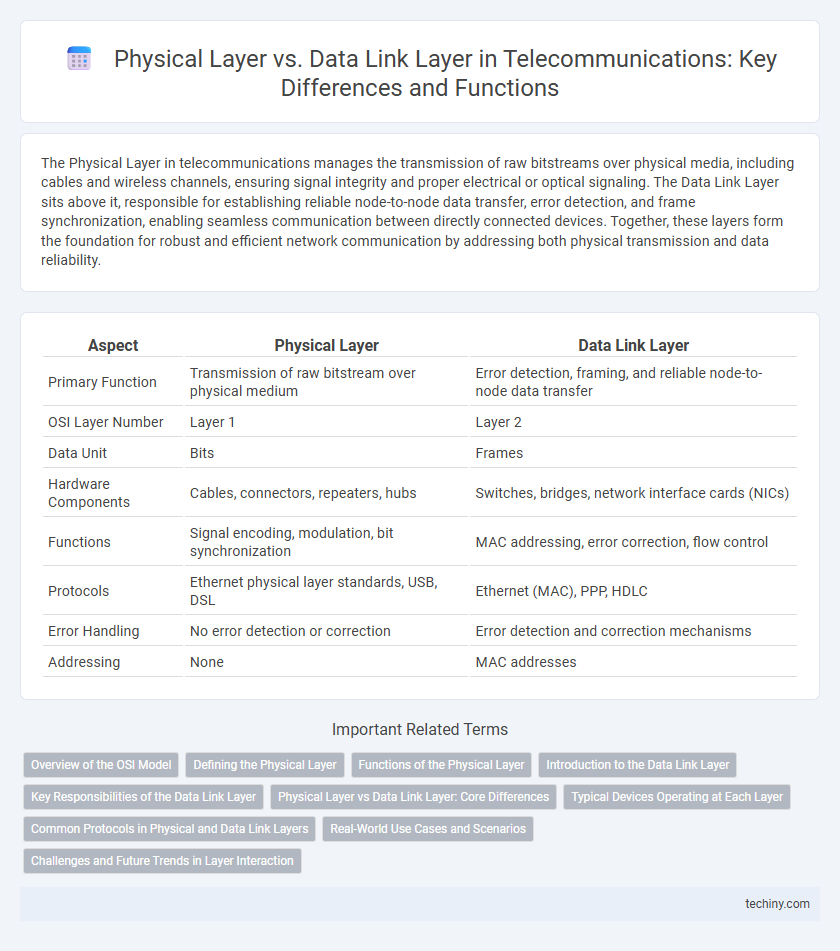The Physical Layer in telecommunications manages the transmission of raw bitstreams over physical media, including cables and wireless channels, ensuring signal integrity and proper electrical or optical signaling. The Data Link Layer sits above it, responsible for establishing reliable node-to-node data transfer, error detection, and frame synchronization, enabling seamless communication between directly connected devices. Together, these layers form the foundation for robust and efficient network communication by addressing both physical transmission and data reliability.
Table of Comparison
| Aspect | Physical Layer | Data Link Layer |
|---|---|---|
| Primary Function | Transmission of raw bitstream over physical medium | Error detection, framing, and reliable node-to-node data transfer |
| OSI Layer Number | Layer 1 | Layer 2 |
| Data Unit | Bits | Frames |
| Hardware Components | Cables, connectors, repeaters, hubs | Switches, bridges, network interface cards (NICs) |
| Functions | Signal encoding, modulation, bit synchronization | MAC addressing, error correction, flow control |
| Protocols | Ethernet physical layer standards, USB, DSL | Ethernet (MAC), PPP, HDLC |
| Error Handling | No error detection or correction | Error detection and correction mechanisms |
| Addressing | None | MAC addresses |
Overview of the OSI Model
The Physical Layer in the OSI model is responsible for the transmission of raw bit streams over a physical medium, handling electrical, optical, or radio signals. The Data Link Layer ensures error-free data transfer by organizing bits into frames and managing node-to-node delivery with error detection and flow control. Together, these layers enable reliable communication by converting digital data into signals and providing error-checked data link connections.
Defining the Physical Layer
The Physical Layer in telecommunications defines the hardware components and transmission techniques used to send raw binary data over a communication medium, including cables, connectors, and signaling methods such as electrical, optical, or radio signals. It establishes the physical characteristics of the network such as voltage levels, timing of voltage changes, physical data rates, and maximum transmission distances. This foundational layer ensures the accurate and reliable transfer of bits before data is structured or error-checked at higher layers like the Data Link Layer.
Functions of the Physical Layer
The Physical Layer in telecommunications is responsible for transmitting raw bit streams over a physical medium, defining electrical, mechanical, and procedural characteristics for data transmission. It establishes and terminates connections, manages data encoding, and deals with signal modulation, voltage levels, and physical interface standards like Ethernet and Fiber Optic cables. The Physical Layer ensures reliable hardware connectivity, laying the foundation for higher layers such as the Data Link Layer, which handles error detection, frame synchronization, and flow control.
Introduction to the Data Link Layer
The Data Link Layer is responsible for node-to-node data transfer, error detection, and frame synchronization, bridging the Physical Layer's raw bit transmission to higher network layers. It ensures reliable communication by packaging bits from the Physical Layer into frames and managing flow control through protocols like HDLC and PPP. Key functions include addressing through MAC addresses and error control using CRC, making it essential for local area network (LAN) communications and preventing packet collisions.
Key Responsibilities of the Data Link Layer
The Data Link Layer in telecommunications is responsible for error detection and correction to ensure reliable data transfer between adjacent network nodes. It manages framing, addressing, and flow control, enabling efficient data packet delivery over the Physical Layer. This layer also handles media access control, regulating how devices share the communication medium and preventing collisions.
Physical Layer vs Data Link Layer: Core Differences
The Physical Layer in telecommunications handles the transmission of raw bitstreams over physical media, defining electrical and mechanical specifications for hardware such as cables and connectors. In contrast, the Data Link Layer manages node-to-node data transfer, error detection, and frame synchronization to ensure reliable communication between directly connected devices. Core differences include the Physical Layer's focus on signal transmission and hardware interface, while the Data Link Layer emphasizes data framing, error control, and flow management.
Typical Devices Operating at Each Layer
Typical devices operating at the Physical Layer include hubs, repeaters, and network cables that handle the transmission of raw bit streams over physical media. Data Link Layer devices primarily comprise switches and bridges responsible for MAC addressing, error detection, and frame synchronization within local networks. These devices collaboratively ensure seamless data transfer by managing physical connections and reliable node-to-node communication.
Common Protocols in Physical and Data Link Layers
Common protocols in the Physical Layer include Ethernet's physical specifications (e.g., 100BASE-TX), USB, and DSL standards that define electrical and mechanical aspects of data transmission. The Data Link Layer employs protocols such as PPP (Point-to-Point Protocol), HDLC (High-Level Data Link Control), and MAC sublayer standards like IEEE 802.3 (Ethernet) and IEEE 802.11 (Wi-Fi) to manage error detection, framing, and medium access control. These protocols collaboratively ensure reliable bit-level transmission and manage data framing, flow control, and error handling between direct network nodes.
Real-World Use Cases and Scenarios
The Physical Layer enables data transmission through hardware components like cables, switches, and modems, essential for establishing the actual communication channel in real-world scenarios such as fiber-optic networks and Ethernet connections. The Data Link Layer manages error detection and frame synchronization, crucial for reliable data transfer in Wi-Fi networks, cellular communication, and local area networks (LANs). Together, these layers ensure seamless and efficient data exchange, with the Physical Layer handling signal transmission and the Data Link Layer providing error correction and flow control.
Challenges and Future Trends in Layer Interaction
Physical Layer challenges include signal degradation, interference, and bandwidth limitations, which directly impact Data Link Layer error detection and correction mechanisms. Future trends emphasize integrating advanced error-resilient coding techniques and adaptive modulation to enhance layer interaction efficiency. Emerging technologies like 5G and IoT demand seamless coordination between layers to support ultra-low latency and high reliability in communication networks.
Physical Layer vs Data Link Layer Infographic

 techiny.com
techiny.com